Exploring the Engineering of Efoil Propellers
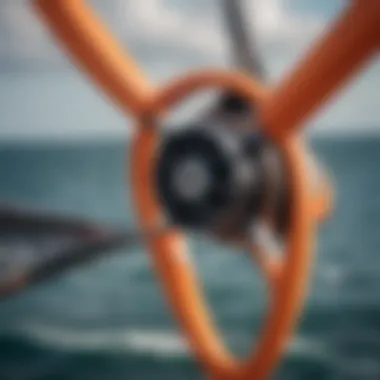
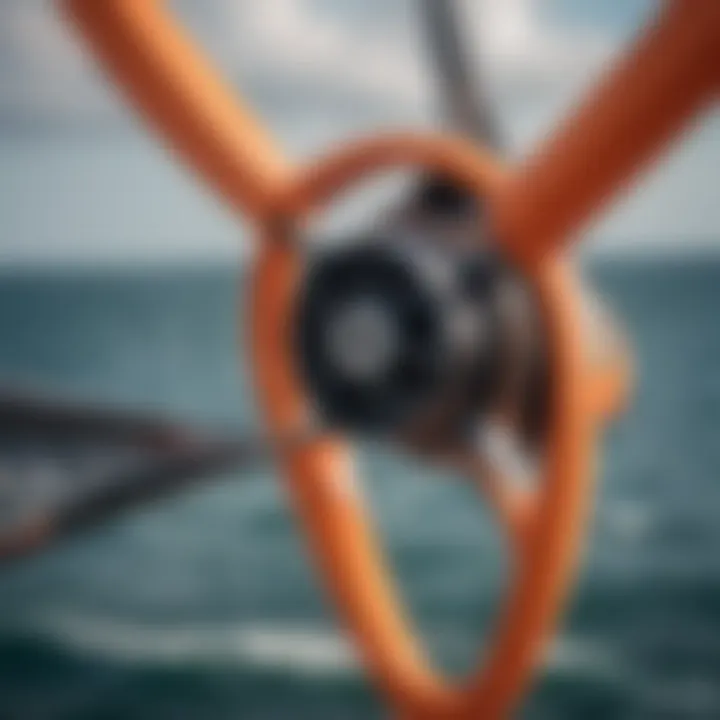
Intro
The world of water sports continues to evolve, with efoiling taking center stage. Efoil propellers play a pivotal role in this exciting new sport, contributing significantly to performance and rider experience. It's vital for kitesurfers and kiteboarding enthusiasts to get a grasp on how these propellers work and how they can enhance one's time on the water.
Efoiling, with its unique blend of surfing and flying over water, has drawn attention from various extreme sports aficionados. However, plenty of people might find themselves puzzled amidst the technical jargon surrounding propeller systems. Understanding the design, material choices, and operational mechanisms of efoil propellers can make or break your experience.
In this article, we'll peel back the layers on efoil propellers — shedding light on their intricate pairing with the overall efoil system, how different designs influence performance, and the maintenance required to keep everything running smoothly.
Equipment Reviews
The choice of equipment is crucial for efoilers. Different elements come together to create an efficient riding experience, and propellers are at the heart of it. Given the sophisticated mechanisms involved, it’s important to look closely at the features available in today's market.
Propeller Designs
When it comes to efoil propellers, designs vary significantly. The shape, pitch, and number of blades can all impact performance. For instance, some propellers are designed with a higher pitch to cut through water efficiently, reducing drag. Others, featuring larger blade surface areas, help with lift and stability during riding. The right design proves essential for those wanting the adrenaline rush of gliding over the waves.
Key Factors to Consider:
- Blade Count: More blades often produce smoother rides, though they may compromise speed.
- Pitch and Diameter: A prop with a higher pitch helps in achieving greater thrust, while diameter affects lift.
Material Choices
The material used to manufacture propellers significantly influences their durability and performance:
- Aluminum: Lightweight and relatively cheap. Common among beginners but might not withstand the rigors of advanced use.
- Carbon Fiber: A favorite among serious riders. It offers strength and is light as a feather, but it comes with a hefty price tag.
Choosing between these materials often depends on individual riding styles, preferences, and budget. Each option possesses its pros and cons, and it's necessary to weigh them when making a decision.
"Investing in quality efoil propellers can enhance both safety and enjoyment, making them a critical component for serious riders."
Maintenance Practices
When maintaining efoil propellers, regular inspections can prevent unexpected issues. Here are a few tips for keeping your equipment in peak condition:
- Routine Cleanings: Saltwater can corrode components. Rinsing down your propeller post-ride helps.
- Visual Checks: Look for any chips or cracks that could compromise performance.
- Lubrication: Ensure all moving parts are well-lubricated to avoid wear and tear.
Preface to Efoil Propellers
Efoil propellers play a crucial role in the world of efoiling, a popular water-based sport that's gaining traction among enthusiasts and extreme athletes alike. These propellers, engineered for efficiency and performance, dictate not just the speed but also the overall experience when gliding over the water. Understanding how efoil propellers function and their significance is pivotal for anyone looking to enhance their performance on the water.
Definition and Overview
At its core, an efoil propeller is a specially designed propeller that powers an electric hydrofoil board, enabling riders to glide above the water's surface. Think of it as the heart of the efoil system, transforming electrical energy from batteries into kinetic energy that propels the board forward. Unlike traditional boat propellers, efoil propellers are meticulously crafted to minimize drag and turbulence, allowing for a smooth ride and enhanced maneuverability.
The design of these propellers incorporates advanced hydrodynamic principles, resulting in shapes that enhance efficiency and performance. Riders experience an exhilarating sensation, almost like flying, as the board lifts off the water. This dynamic interaction of water with the propeller is what gives efoiling its unique charm and appeal.
Importance in Efoiling
The importance of efoil propellers cannot be overstated. They not only determine the speed and agility of the ride but also significantly affect energy consumption. A well-matched propeller to an efoil system can lead to better battery life and more exhilarating experiences on the water. If a rider chooses the wrong propeller, they might find themselves grappling with sluggish performance, reduced efficiency, and ultimately, a less enjoyable ride.
Here are a few specific reasons why efoil propellers matter:
- Efficiency: The right efoil propeller minimizes drag, thus reducing power consumption, which translates to longer ride times.
- Stability: A well-designed propeller contributes to the stability of the efoil, allowing riders to handle varying water conditions with ease.
- Performance: Different designs can enhance performance characteristics, catering to specific rider preferences, whether speed or agility is prioritized.
"Choosing the right efoil propeller is like finding the perfect partner for your dance; it must complement your moves and enhance your experience on the water."
In summary, efoil propellers create the bridge between the rider and the thrilling sensation of flying over water. They encapsulate the responsibility of guiding the rider’s journey, underscoring their significance in this burgeoning sport.
Fundamental Principles of Propeller Design
Understanding the fundamental principles of propeller design is like grasping the very heartbeat of efoiling. Without a solid grasp of these key elements, one might find themselves struggling to maximize performance, control, and efficiency while carving through water.
Efoil propellers are not mere appendages; they are intricately engineered components that dramatically influence the rider's experience. From how quickly a rider can achieve speed to the responsive handling of the efoil itself, propeller design encompasses multiple layers of physical principles and material science. Here, we will delve into hydrodynamics and thrust, alongside blade shape and aerodynamics.
Hydrodynamics and Thrust
At the crux of propeller performance lies hydrodynamics. This branch of fluid mechanics studies how water (the fluid) interacts with solid bodies like propellers, and understanding this interaction is paramount for anyone venturing into the realm of efoiling. When a propeller spins, it pushes against the water, creating thrust. This thrust propels the efoil forward. However, not all thrust is equal; several factors come into play:
- Angle of Attack: The angle at which water strikes the blades—get this wrong, and the propeller may not grab the water efficiently, resulting in wasted energy.
- Speed and RPM: Higher speeds can yield a larger volume of water displacement, but it may not always translate to efficient thrust. Proper calibration is essential.
- Water Density: Saltwater and freshwater behave differently. Higher density can provide better support but it changes hydrodynamic behavior.
Ultimately, the thrust produced must be well balanced with drag—the resistance in water—so that the efoiler can glide seamlessly. A key takeaway? It’s a balancing act between these dynamics.
Blade Shape and Aerodynamics
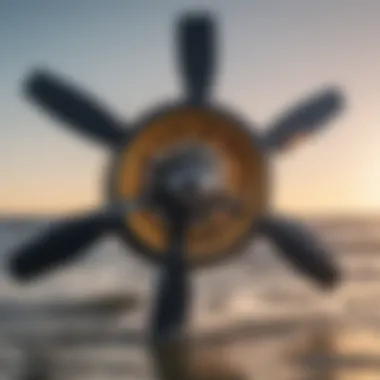

Turning our attention to blade shape, we find that form follows function. The design of an efoil propeller's blades is crucial in minimizing drag while maximizing lift and thrust. Think of the blade as a wing navigating through air, albeit in this case, it's the water that's the medium.
Consider these elements when examining blade shape:
- Profile: A wider blade may provide greater thrust, but too much width might increase drag. Conversely, a narrower blade can slice through the water but might not generate enough thrust at lower speeds.
- Camber: This refers to the curvature of the blade. A cambered blade can enhance lift, which is beneficial for initial acceleration during takeoff.
- Tip Design: Blades can have rounded or pointed tips, impacting how efficiently they cut through water and the cavitation effects, which occur when low-pressure areas form and cause bubbles, adding resistance.
"The little details in propeller design can mean the difference between an exhilarating ride and a frustrating struggle on the water."
It’s important to remember that these considerations may vary depending on the intended use of the efoil, whether for gemütlichen leisurely rides or cutting-edge performance in competitions.
In summary, mastering the fundamentals of efoil propeller design illuminates the path to high-performance and exhilarating efoiling experiences. Without these principles, navigating choppy waters would be a more tedious affair than a thrilling venture.
Materials Used in Efoil Propellers
Efoil propellers are not just pieces of equipment; they're the heart of your efoiling experience. The right materials can make or break performance, durability, and even safety out on the water. Knowing what your propellers are made of is like having the cheat sheet to an exam—you wouldn't dare go in without it.
When discussing the materials for efoil propellers, two main contenders come into play: metals and composites. Each brings with it a set of advantages and drawbacks that could influence a rider's choice depending on various factors, such as riding style or conditions.
Metals vs. Composites
Metals, chiefly aluminum and stainless steel, have long been known for their strength and durability. An aluminum propeller, for instance, can withstand the harshest elements. Meanwhile, stainless steel offers resistance to corrosion, which is a big deal for efoiling enthusiasts who often encounter salty waters. But pay attention to weight. Metals tend to be heavier, which can impede the light and buoyant experience efoiling is known for.
On the flip side, composites made of materials like carbon fiber or fiberglass are lightweights in comparison. This reduced weight translates into better speed and agility on the water, aligning closely with what extreme athletes crave. However, composite propellers are not entirely bulletproof. They can be more prone to damage from impacts, which is something every rider should consider.
"Choosing the right material could be the difference between gliding effortlessly or struggling against the waves."
So, what's the final verdict? It really comes down to personal preference, riding conditions, and what you value most in your experience. Some hardcore riders may swear by the unyielding nature of metals, while others could argue that the nimbleness offered by composites is simply unbeatable.
Weight and Durability Considerations
When it comes to efoil propellers, weight and durability are not just buzzwords; they are essential considerations that determine overall performance. A lightweight propeller allows for quicker acceleration and maintains the hydrodynamic efficiency vital for cutting through water smoothly.
However, lightness isn’t everything. Durability plays a critical role, especially in extreme conditions. Imagine cruising at high speeds, and your propeller chips or cracks due to underwater debris—suddenly, you're back to square one.
- Lightweight Benefits:
- Durability Importance:
- Increased speed and agility.
- Enhanced responsiveness to rider commands.
- Improved battery efficiency, allowing for longer rides.
- Resistance to damage from impacts.
- Longevity of the equipment, saving costs in the long run.
- Reliability in various water conditions.
The ideal combination varies from one rider to another. Often, a balance must be struck—after all, you don't want a propeller that can float in the air but can't take a bump without shattering.
Ultimately, the decision often boils down to how you ride. Whether you prefer to carve through the waves like a dancer or hurl yourself off the wakes like a daredevil, understanding the roles of weight and durability in propeller materials will help you tailor your setup for the best performance.
Types of Efoil Propellers
Understanding the various types of efoil propellers is key to maximizing not just performance, but also the overall experience on the water. Each type serves a specific purpose, catering to different conditions, riding styles, and rider capabilities. The choice of propeller can greatly influence the dynamics of efoiling, making it essential for enthusiasts to comprehend the advantages and nuances of each variant.
Fixed vs. Adjustable Pitch
Fixed pitch propellers maintain a consistent blade angle, creating stable thrust and power delivery. This design is often seen as the go-to choice for those wanting simplicity in operation. Fixed pitch propellers offer a few benefits:
- Simplicity: Less adjustment means easier maintenance and quicker replacements.
- Reliability: Without moving parts to adjust the pitch, these props can often be more durable.
However, they do fall short in certain aspects. For instance, performance can vary based on riding conditions; a fixed pitch might not allow for optimal efficiency at all speed ranges.
On the flip side, adjustable pitch propellers allow for customization. With the ability to modify the angle of the blades, riders can adapt their efoil for different situations. This provides several key advantages:
- Optimized Efficiency: Riders can shift the pitch based on conditions, improving acceleration or top speed as needed.
- Versatility: Useful for varying water states, whether choppy or flat.
However, there’s a catch. Adjustable pitch propellers may require more frequent maintenance and adjustments, which could be a drawback for some riders. Balancing performance gains against the need for upkeep is a consideration worth making.
Multi-blade vs. Multi-hull Designs
When it comes to the arrangement of the blades, both multi-blade and multi-hull designs offer unique benefits and challenges. Multi-blade propellers typically feature three or more blades. They work well by providing a larger surface area for thrust and minimizing drag. Here's how they stack up:
- Enhanced Thrust: More blades can create better thrust at lower speeds.
- Smooth Operation: Generally leads to a quieter ride.
That said, they may not be ideal in all scenarios, as they can create more resistance, potentially affecting high-speed performance. Riders looking for stability might lean towards multi-blade setups for added confidence on the water.
On the other hand, multi-hull designs introduce a radical departure in propeller functionality. Instead of focusing solely on blade count, these designs integrate structural elements. The benefits of a multi-hull system include:
- Improved Maneuverability: These designs often allow efoilers to change directions more sharply, which appeals to more aggressive riding styles.
- Better Stability: The broader foundation can handle unstable waters more effectively, offering a smoother ride when the surf is kicking.
However, these systems can be complex. If you're not looking for that added intricacy, it could discourage the more casual rider.
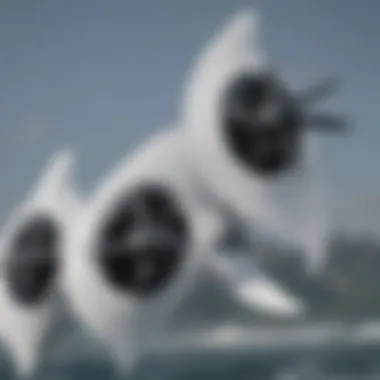
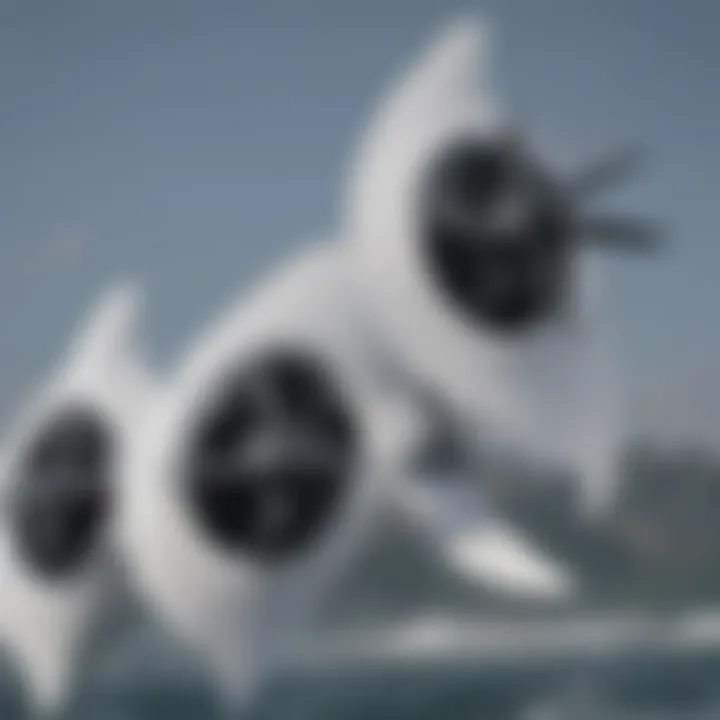
Epilogue
In summary, the choice between fixed and adjustable pitch, or the decision to go with multi-blade or multi-hull designs, plays a pivotal role in shaping the efoiling experience. Each type has its own set of merits and detriments that can cater differently to the needs of riders.
Understanding these types not only enables kitesurfing enthusiasts to select the best propeller for their riding style and conditions but also fosters a deeper connection to the engineering marvel that efoil systems represent.
"Choosing the right propeller is not just about performance; it’s about crafting the ultimate experience on the water."
Performance Metrics of Propellers
Understanding the performance metrics of propellers is crucial for anyone serious about efoiling. These metrics determine how well a propeller performs under various conditions, affecting both speed and rider experience. Different configurations can lead to varied results in efficiency, control, and maneuverability, all of which are essential for the rider’s enjoyment and safety on the water. Balancing these metrics helps in selecting the right propeller for specific needs, ensuring an optimal riding experience.
Speed and Efficiency
When it comes to speed and efficiency, efoil propellers need to strike a careful balance. Speed refers not only to the maximum velocity achieved but also to how efficiently that speed is maintained over time. Efficiency in propellers usually boils down to how much power from the electric motor translates into forward motion. A propeller that can produce high thrust with minimal energy loss is an ideal choice.
Factors contributing to both speed and efficiency include the following:
- Blade design: Curvature, length, and surface area all play roles in optimizing performance.
- Pitch: The propeller pitch—a measure of how far the propeller would advance in one rotation—affects both acceleration and top speed.
- Material and Weight: Lightweight materials like composites aid in faster speeds, as they require less energy to propel.
Impacts of speed and efficiency on the riding experience cannot be understated. Riders who prefer cruising along picturesque coastlines might opt for efficiency over speed to prolong their sessions, while thrill-seekers may prioritize speed to achieve that exhilarating rush. Ultimately, a balance tailored to personal preference leads to the best outcomes.
Control and Maneuverability
Control and maneuverability are equally significant metrics to consider. These influence how easily a rider can adjust their path or react to waves and currents, critical for safety and enjoyment. Simpler or tighter control makes for a better efoiling experience.
Here are a few elements that affect control and maneuverability in efoil propellers:
- Blade flexibility: Some propellers are designed with varying degrees of stiffness. Flexible blades can help in creating lift in choppy conditions, whereas stiffer blades may provide better control at high speeds.
- Propeller diameter: A wider diameter can offer increased lift, making it easier for the rider to maintain stability. However, it may require more power and thus influence speed and efficiency.
- Response time: This involves how quickly the propeller reacts to changes in the motor speed, affecting how sharply a rider can turn or make quick movements.
Determining the right balance between speed and control comes down to personal style and environmental conditions. Riders should gauge the kind of waves, currents, and space they'll be navigating to choose an appropriate propeller design.
"A well-chosen propeller is the heart of an effective efoil setup, echoing through the ride’s every twist and turn."
In summary, metrics such as speed, efficiency, control, and maneuverability not only define propeller performance but also directly impact the overall efoiling experience. Whether aiming for high speeds or smooth control in tricky waters, understanding these metrics sets the stage for informed decisions and thrilling rides.
Choosing the Right Propeller for Efoiling
Selecting the correct propeller for efoiling is not just a matter of picking something and hoping for the best. It's pivotal for maximizing your experience on the water. The right propeller can make a world of difference in terms of speed, control, and fluidity while gliding over the waves. Narrowing down the choices can also enhance the efficiency of your setup based on different conditions and personal requirements. The concepts of rider weight, water conditions, and the desired speed are integral to this decision-making process.
Factors to Consider
Rider Weight
When it comes to rider weight, it's crucial to appreciate how it influences overall performance. Lighter riders might find themselves zipping along effortlessly, requiring a propeller design that maximizes lift while not sacrificing thrust. Conversely, heavier riders have different needs. They often benefit from blades that offer more thrust and stability. This aspect becomes especially apparent when considering the board's planing characteristics. An advantage of choosing a propeller tailored to rider weight means better handling and responsiveness, enhancing the enjoyment and efficiency of each ride.
Water Conditions
Water conditions are another key consideration. Whether you're faced with calm lagoons or choppy seas, the propeller's design needs to account for varying resistance and forces at play. In rough waters, a stronger blade that can handle turbulence is advantageous; it provides stability and better control. On the other hand, in calmer conditions, you might seek a propeller tuned for finesse and speed, cutting through water without much drag. This flexibility in design helps riders adapt to spontaneous environment changes, giving them the edge to ride with confidence.
Desired Speed
Desired speed plays a significant part in the selection of a propeller. Some riders thrive on pushing limits, seeking a blade that’s capable of high speeds with less resistance. These propellers often feature a narrower blade design, which helps slice through the water more efficiently. Alternatively, for those who prefer a more leisurely pace, a propeller designed for slow speeds can offer more stability, allowing for easier navigation and greater comfort on the water. Ultimately, irrespective of one’s speed aspirations, aligning propeller choice with this characteristic ensures a more tailored riding experience.
Personal Preferences
While technical aspects play a huge role in choosing a propeller, personal preferences shouldn't be overlooked. Some riders might prioritize agility over speed, while others seek a perfectly smooth glide without sudden jolts. It’s all about matching hardware with rider personality. Having a prop that contours to one’s individual style significantly enhances the adventure and enjoyment of efoiling.
Remember, the propeller is the heartbeat of your efoil setup. Choosing wisely shapes your ride's rhythm and flow.
Maintenance of Efoil Propellers
Maintaining efoil propellers is more than just a chore; it’s a crucial practice that ensures optimal performance and prolongs the lifespan of these sophisticated components. A well-kept propeller translates to better efficiency and a smoother ride, giving enthusiasts a seamless experience on the water. Much like regularly changing the oil in a car, attending to propeller maintenance can save costly repairs down the road and keep your gear functioning at its peak.
Inspection and Cleaning
Regular inspection is vital in identifying any wear and tear that might affect the efoil's performance. Taking a few moments before and after each session to check your propeller can spare you from more significant issues later. Look out for any cracks or chips on the blades; these small inaccuracies can lead to reduced thrust and increased drag, ultimately impacting speed and maneuverability.
Cleaning is another essential step in maintenance. After riding, fresh water should rinse off any salt, sand, or debris clinging to the propeller. Salt can lead to corrosion over time, which can significantly degrade its performance. A soft brush can help scrub away stubborn residue without scratching the blades. It’s a simple act, but it speaks volumes in terms of care and attention.
Keeping the propeller's leading edges free from damage is also important, as this area is critical in affecting the water flow around the blades. Some riders swear by using a dedicated propeller bag during transport to minimize accidental dings or bends. Just these small routines can make a colossal difference.
"A stitch in time saves nine; that’s especially true for your efoil propellers. Detecting issues early can save you time and money later on."
Dealing with Damage
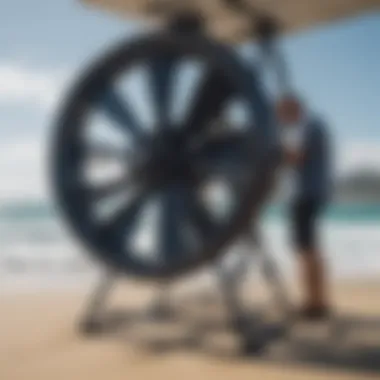
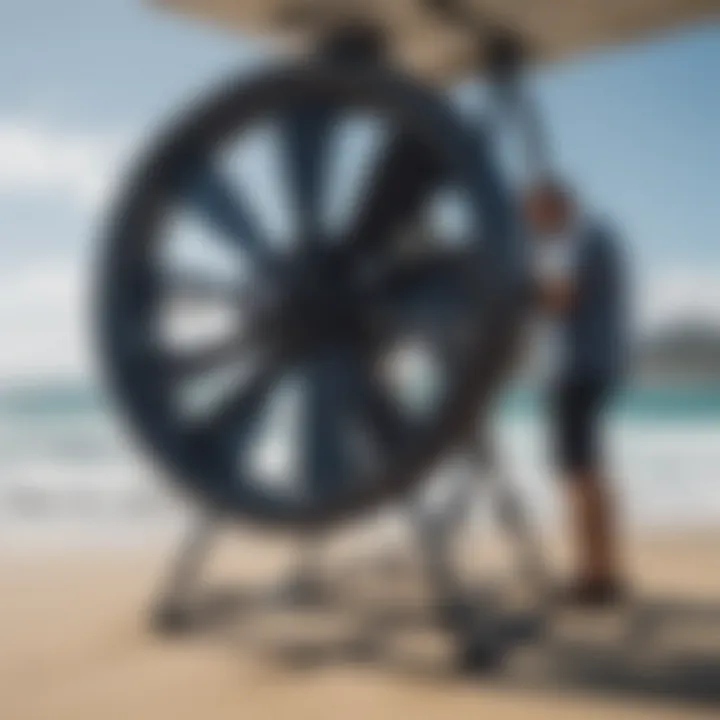
Inevitably, no matter how careful you are, damage may occur—whether it’s from rocks, debris in the water, or an unfortunate mishap during transport. When addressing damage, the first step is to assess the extent of the issue. Minor dings might be repaired with specific resin kits, while more severe damage could necessitate professional assessment.
Here are some considerations for handling propeller damage:
- Evaluate the Damage: Determine if it’s something you can fix yourself or if it requires professional intervention.
- Repair Kits: Keep a set of repair kits handy. They come in especially useful for minor chips or scratches that could compromise performance.
- Replacement vs. Repair: Sometimes, it’s more cost-effective to replace rather than repair, especially if damage affects balance and shape.
- Prevention: As the saying goes, an ounce of prevention is worth a pound of cure. Investing in protective covers when transporting can drastically decrease the chances of damage.
Moreover, documenting each inspection and maintenance procedure can create a valuable history for your efoil propeller, which can be useful for future reference or even resale—showing potential buyers that the equipment was cared for properly.
To summarize, the maintenance of efoil propellers may appear tedious, but it's essential for a rewarding riding experience. Regular inspections, thorough cleaning, and a proactive approach to damage can keep you slicing through the water smoothly, making for those gloriously exhilarating moments that make extreme sports worth every effort.
Cutting-edge Innovations in Propeller Technology
Efoil propellers are at the forefront of marine technology, continuously evolving to meet the demands of water sports enthusiasts. Understanding cutting-edge innovations in propeller design is crucial, as these advancements drive performance improvements and enhance the rider experience. As technology progresses, the introduction of new materials and systems is reshaping how these propellers function, leading to a more efficient and environmentally friendly approach to efoiling. Let's delve into two significant areas of innovation: variable geometry systems and advanced materials and design techniques.
Variable Geometry Systems
Variable geometry in propeller systems refers to mechanisms that allow the blade angle or shape to change during operation, adapting to varying conditions in real-time. This adaptability can yield numerous benefits:
- Optimized Performance: By altering the pitch of the blades according to environmental factors like water density and rider weight, these systems can maximize thrust while minimizing drag. It’s like having a Swiss Army knife—one tool that fits multiple needs.
- Improved Efficiency: Riders will notice that power consumption decreases as the propeller adjusts to optimize performance. This results in extended battery life and increased runtime, which is particularly valuable in competitive circumstances.
- Enhanced Control: Riders can enjoy finer handling capabilities, which can be particularly beneficial in challenging water conditions. Quick adjustments to the propeller geometry help navigate through rough patches with more ease and confidence.
Moreover, the integration of such systems is not just a question of technical sophistication. There’s a real consideration regarding the learning curve these innovations may present for riders and researchers alike. Some might find it a tad tricky to adapt, especially if they're used to simpler designs.
"Innovations in variable geometry systems empower riders to adapt and optimize their experience on the water, merging performance with user-friendly design."
Advanced Materials and Design Techniques
The world of efoil propellers is also witnessing a shift towards advanced materials and design techniques. Here are the focal points:
- Composite Materials: Utilizing carbon fiber and specially engineered plastics is gaining traction. These materials are lightweight yet strong, leading to better performance and durability. The lighter the propeller, the less energy required to move it through water.
- Additive Manufacturing: The advent of 3D printing technology is revolutionizing how designs are produced. It allows for intricate designs that were previously too expensive or complex to manufacture through traditional means.
- Hydrophobic Coatings: Applying advanced coatings to surfaces reduces water friction, allowing propellers to glide through with less resistance. This leads to gains in speed and efficiency.
Adapting these practices not only enhances the propeller's overall functionality but also addresses concerns related to environmental impact. Products created with sustainable practices in mind resonate with eco-conscious riders, catering to a growing demographic in kitesurfing and extreme sports communities. Moreover, as new materials are tested, it raises questions about long-term performance and maintenance requirements, demanding attention from manufacturers and users alike.
In summary, the innovations in efoil propeller technology are not just performance upgrades; they reflect a holistic approach to design, efficiency, and environmental consciousness. As kitesurfers and extreme sports athletes constantly seek ways to elevate their experience, these advancements pave the way for the future of efoiling.
Environmental Impact of Efoil Propellers
The discussion on efoil propellers extends beyond their mechanics and performance; it reaches into the realm of environmental concerns. As enthusiasts of kitesurfing and extreme sports push for innovation in water sports, there's also a growing awareness of the potential ecological impacts. Understanding how these propellers affect our environment is crucial. It allows manufacturers and riders alike to pursue practices that honor the ecosystems in which we engage.
Noise Pollution Considerations
One of the primary environmental challenges posed by efoil propellers is noise pollution. The whirring sounds of propellers can become intrusive, particularly in sensitive marine environments. Fish and marine mammals rely on sound for communication and navigation, and excessive noise can disrupt these natural behaviors.
- Impact on Ecosystems: While efoiling might seem serene from the surface, underwater noise can have a profound impact. Studies have shown that high decibel levels can drive fish away from spawning grounds and affect their ability to locate food.
- Regulatory Measures: As the popularity of efoiling expands, regulations concerning noise emissions may become more stringent. Riders may soon find themselves needing quieter options to comply with both local laws and ecological best practices.
Adopting designs that minimize noise can not only protect ecosystems but also enhance the efoiling experience, making it more enjoyable for everyone involved.
Sustainability of Materials
Another significant consideration in the environmental impact of efoil propellers is the materials used in their construction. The trend towards using selected materials can shape everything from durability to ecological footprint. Many manufacturers focus on lightweight materials, but the source and sustainability of these materials are equally important.
- Eco-friendly Choices: Plastics and composites have been central to the development of many high-performing propellers. While some might question the reliance on such materials, advancements in bioplastics and recycled composites present viable alternatives that could lessen our environmental footprint.
- Lifecycle Considerations: Understanding the entire lifecycle of the materials used is paramount. Where they come from, how they are processed, and what happens after their use must be taken into account. This is a pivotal step towards minimizing waste and ensuring sustainable practices.
Moreover, promoting a circular economy in the propeller manufacturing industry can pave the way for a more sustainable future. Riders who make thoughtful material choices align themselves with this movement, thereby encouraging a broader shift in industry standards.
"The future of efoiling not only rests on advancements in performance but also demands a commitment to sustainability that respects our oceans."
With careful consideration of both noise pollution and material sustainability, enthusiasts and manufacturers can significantly reduce the ecological footprint of efoiling. Navigating these discussions thoughtfully ensures that water sports remain enjoyable while protecting our vital waterways.
Future Trends in Efoil Propeller Design
The world of efoiling is always on the move, with rapid advancements reshaping how we think about propeller design. Understanding these future trends is vital for anyone passionate about the sport, as they directly affect performance, efficiency, and riding experience. Whether you are a seasoned rider or a newcomer eager to embark on thrilling adventures, being aware of these innovations can be the difference between gliding smoothly across the water and wrestling with underperforming gear.
Emerging Technologies
The efoil industry is currently witnessing a wave of new technologies that promise to elevate the performance and user-friendliness of propellers. One notable trend is the development of 3D printing for precision engineering. This enables manufacturers to create highly customized blades tailored to specific water conditions and rider styles, ensuring optimal thrust and efficiency. This capability is transforming traditional approaches, as riders can now have personalized solutions without the lengthy wait times associated with standard production methods.
Furthermore, advancements in computer-aided design (CAD) tools are allowing engineers to simulate various propeller configurations in virtual environments before committing to physical prototypes. These simulations can drastically reduce design cycles, leading to faster rollout of more effective propeller designs that handle better in dynamic water conditions.
In addition, there's a growing interest in bio-inspired designs. Nature has been the mother of invention for ages, and by mimicking the efficiency of shapes found in marine life, designers aim to enhance hydrodynamic performance. For example, propellers resembling the flippers of manta rays could provide better lift and smoother rides through varying water speeds and turbulence.
Integration with Smart Systems
As technology becomes increasingly intertwined with our daily pursuits, the integration of smart systems into efoil designs represents another leap forward. Riders can now expect to find propellers equipped with real-time performance feedback systems. These systems utilize sensors that provide instant data on speed, thrust, and even water conditions, allowing for immediate adjustments to riding technique or gear settings. Imagine having a dashboard at hand, fueling your ride with information to enhance your performance at every twist and turn.
Moreover, advancements in AI-driven analytics offer a glimpse into predictive performance modeling. This means that, over time, your equipment will adapt and optimize for your specific riding style and environmental conditions. By collecting data on past rides, algorithms can suggest adjustments or even provide maintenance reminders, ensuring your propellers are always up to snuff.
As these smart technologies become more common, the landscape of efoiling will shift, making rides not just a personal challenge, but a connected experience capable of sharing insights with the broader community. Whether through mobile apps or integrated dashboards, the future looks promising for both tech lovers and extreme sports enthusiasts.
"Emerging technologies in efoil propellers are not just about performance; they’re about enhancing the overall experience of riding on water."
With these trends unfolding, it’s exciting to imagine where the efoiling journey will go next. As riders continue seeking out thrilling experiences, keeping an eye on these developments will be essential to staying ahead in the game.







